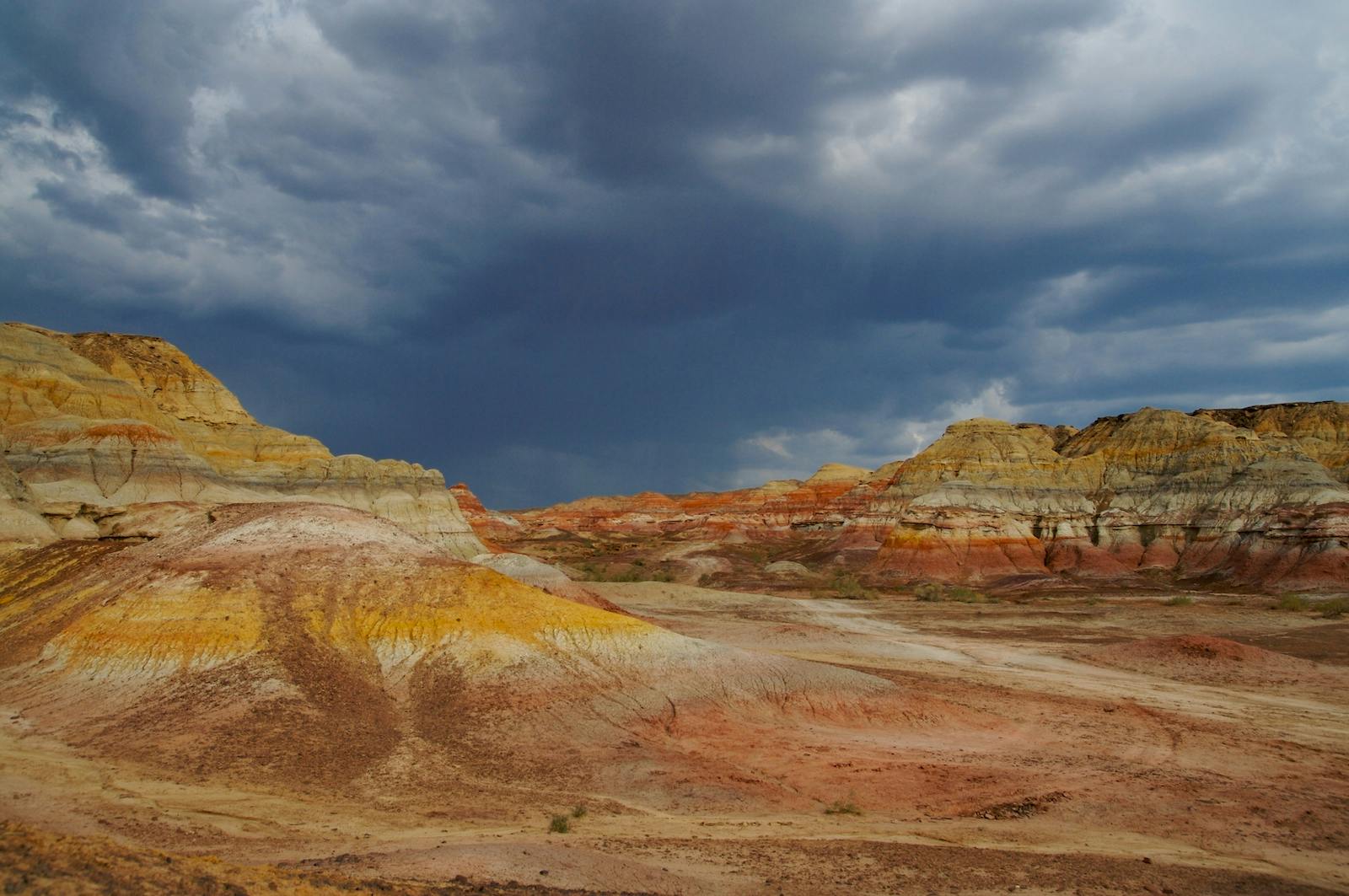Junggar Basin Semi-Desert
The ecoregion’s land area is provided in units of 1,000 hectares. The conservation target is the Global Safety Net (GSN1) area for the given ecoregion. The protection level indicates the percentage of the GSN goal that is currently protected on a scale of 0-10. N/A means data is not available at this time.
Bioregion: Junggar Semi-Desert & Ermin Valley Steppe (PA38)
Realm: Eastern Eurasia
Ecoregion Size (1000 ha):
30,490
Ecoregion ID:
827
Conservation Target:
64%
Protection Level:
2
States: China, Kazakhstan, Mongolia
The Junggar Basin is one of the great intermontane basins of Central Asia. Situated between the Tian Shan and Altai mountain ranges, it supports a vast expanse of semi-desert habitat. Mountain gaps to the north admit enough precipitation for thin steppe vegetation, too meager for livestock but adequate for well-adapted wild mammals.
Mean annual precipitation is 80–100 mm in the center of the basin, increasing to 100–250 mm at the margins. The same gaps that bring precipitation into the Junggar Basin also expose it to Siberia’s fierce winter cold, producing a harsh continental climate.
The Gurbantunggut Desert is the dry heart of the Junggar Basin. Vegetation here is a thin scrub of densely branching, tiny-leaved Anabasis with occasional dwarf woodlands of black saxaul, a salt tolerant shrub of cold, Central Asian desert regions. Saxaul is ecologically significant because it is the one desert plant species robust enough to stabilize the sand dunes, limiting the extent of shifting sand relative to the Taklimakan Desert to the south..
.jpeg)
The flagship species of the Junggar Basin Semi-Desert ecoregion is the Przewalki’s horse. Image credit: aiklee, iNaturalist
Nitraria sphaerocarpa, a pioneer species of sand dune habitat, has seedlings that can grow up through more than 10 cm of shifting sand. The less-arid perimeter of the Junggar Basin supports Caragana and other shrubby legumes that provide browse for hoofed mammals
Oases in the eastern part of the Junggar Basin are fed by snowmelt from the Tian Shan mountain range, while snow from the Altai Mountains sustains oases in the north. Both regions support deciduous forest stands of desert poplar, together with tamarisk, willow, and other shrubs.
Alluvial basins at the foot of the mountains once supported productive marsh, meadow, and riparian vegetation. In the Chinese part, such habitats have been under irrigated agriculture since they were depopulated and resettled by outsiders in the 18th Century. In Kazakhstan, larger lakes such as Lake Saissan, fed by runoff from the surrounding mountains, continue to support extensive wetlands.
The Junggar Basin is one of the last places where Przewalski’s horse survived in the wild. A few centuries ago, two subspecies ranged between eastern Mongolia and central Europe, inhabiting productive forest and plains habitat. Over time, the wild horse was marginalized to steppe and semi-desert. Today Przewalski’s horse is extinct in the wild, although captive populations exist and the species has been successfully reintroduced to the Mongolian-Manchurian grasslands of central Mongolia.
A population of Przewalki’s horse has also been introduced into the Kala Maili Shan Nature Reserve (17,000 km2) in the western part of the Junggar Basin semi-desert ecoregion and was reported in 2007 to include more than 100 individuals.
The northeastern part of Junggar Basin includes the Dzungarian section of Great Gobi National Park, Mongolia, an International Biosphere Reserve that supports black-tailed gazelle and the largest remaining herds of Asiatic wild ass. A population of critically endangered wild Bactrian camels survives here as well, but the size and condition of this population remain uncertain.
Several species of jerboa (or jumping mice) inhabit the Junggar Basin. These small, burrowing mammals have been honed by natural selection to escape owls and other birds of prey: well-developed hind legs enable them to leap three meters and a long, flexible tail helps to maintain their equilibrium during abrupt trajectory adjustments. Reptiles of the Junggar Basin include several nocturnal gecko species, including Przewalski's wonder gecko, endemic to this part of Central Asia.
Seed plant diversity hotspots have been identified in the Junggar Basin, but they do not align well with the existing protected area network. Additional protected areas could be cited for plant conservation.
Priority conservation actions for the next decade
- Secure habitat for wild camel in Mongolia, free from threats such as off-road vehicles, poaching, and illegal gold mining.
- Develop protected status for plant biodiversity hotspots in the Junggar Basin.
- Clarify the boundaries of nature reserves in Xinjiang, as recommended by the Chinese Academy of Forestry.
-
-
Carpenter, C. 2000. Junggar Basin semi-desert. https://www.worldwildlife.org/ecoregions/pa1317#. Accessed December 2018.
Huang, J., Liu, C., Guo, Z., Ma, K., Zang, R., Ding, Y., Lu, X., Wang, J., Yu, R. 2018. Seed plant features, distribution patterns, diversity hotspots, and conservation gaps in Xinjiang, China. Nature Conservation 27: 1-15.
Yadamsuren, A., Dulamtseren, E., Reading, R.P. 2012. The conservation status and management of wild camels in Mongolia. n.a. -
Cite this page: Junggar Basin Semi-Desert. Ecoregion Snapshots: Descriptive Abstracts of the Terrestrial Ecoregions of the World, 2021. Developed by One Earth and RESOLVE. https://www.oneearth.org/ecoregions/junggar-basin-semi-desert/
-



